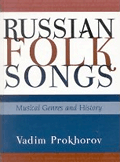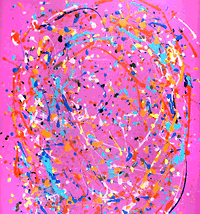Literature
Books
 Russian Folk Songs: Musical Genres and History
Russian Folk Songs: Musical Genres and History
General Introduction - an excerpt
"Russian folk songs are a living history of the Russian people, rich, vivid and truthful, revealing their entire life," wrote the great Russian writer, Nikolai Gogol (1809-1852).
Historical and classificational surveys of the musical genres of Russian folk songs. "A superbly presented study."
"If the historian desires to learn about the everyday life of the people, the elements of their character, all the shades of their feeling; about their concerns, their suffering and their amusements; if he wishes to understand the spirit of the past age, the nature of the people as a whole and of each individual separately, then the history of the people will be revealed to him in all its grandeur."
Indeed, songs accompanied all activities of the Russian people and were a counterpart of the mental and emotional spheres of their life. "Already in their cradle," wrote the literary critic, Nikolai Dobrolyubov (1836-1861), "children were lulled by songs; growing, they learned to sing themselves. Young people gather for an evening party--songs are heard there. Spring comes--villagers greet it, leading roundelays, weaving wreaths and inevitably singing songs. A peasant is going to plow--he eases the hardship of his work with a song. When peasants reap their crop, a song freshens them. A song attended the villagers not only in all their work and social activities but followed them in their family life too." The Russian people were born, married and buried with songs.
Foreign visitors also remarked on the fact that songs were a constant and loyal companion of the Russian people. "In our route through Russia I was greatly surprised at the propensity of the natives to singing," wrote William Coxe, who traveled through 18th century Russia.
"Even the peasants, who acted in the capacity of coachmen and postilions, were no sooner mounted than they began to warble an air and continued it, without the least intermission, for several hours … The postilions sing from the beginning to the end of a stage, the soldiers sing continually during their march, the countrymen sing during the most laborious occupations, the public houses re-echo with their carols and in the still evening I have frequently heard the air vibrate with the notes from the surrounding villages."
Russian people, indeed, sang their songs in all situations and at all times. Subsequently, one could be under the impression that Russian folk songs constitute a homogeneous organism, orderly evolving in time and space. Nothing could be further from the truth. The term "the Russian folk song" embraces a variety of musical and poetic genres, which are better called categories or groups, since the term "genre" cannot be rightfully applied?so various and intertwined are these groups. For example, as far as musical and poetical devices are concerned, a particular calendar song can belong to a khorovod genre which includes dance and game activities and which can have both agricultural ritual and lyric non-ritual content. The enormous geographic dimensions of Russia and the complexity of its history and ethnography constitute another problem, which expressed itself in the immense variety of regional traditions of Russian folklore. So it should not come as a surprise that the classification of Russian folk songs has always been a painstaking problem and paramount challenge. In one region a song can be performed as a wedding song; in another as a dance song. In different places the same song can be sung as a khorovod song and a protracted song. At the same time, undoubtedly, an agricultural song or a wedding song can be danced; a soldier song can have lyric content; and comical content occurs in khorovod and dance songs and in the wedding ritual.
Studying the genesis of Russian folk songs from a historic perspective also presents an oft-insurmountable problem. It is indisputable that many Russian folk songs (calendar songs and work songs, for instance) can be linked to the epoch of the primitive or patriarchal society of the ancient Eastern Slavic people. Some can be traced to the time of the formation of the Russian people as a nation. But this can be done only theoretically--studying the musical and poetic characteristics, taking into account, though, that during their centuries--old evolution Russian folk songs had gone through substantial changes--since the first anthologies of Russian folk songs appeared only in the 18th century. (Texts of folk songs began to be collected in the 17th century, first by foreign travelers.) They all were incomplete and unscientific.
Still, there are some basic ways to categorize Russian folk songs. It can be done according to their origins, their purpose and social function, a place of their performance, their subject matter (content), their poetic text, and their musical form. Most of the time Russian folk songs are grouped according to their thematic (subject matter) similarity (love songs, family songs, soldier songs, etc.), or according to their application to community life and purpose (calendar songs, a wedding ritual games, dance songs, etc.). This is not strictly a genre grouping, since it does not take into consideration the musical and poetical characteristics, not to mention their historic and dialectic features. It should be borne in mind, however, that in the case of Russian folk songs the mentioned factors are often inseparably interwoven. In a particular song, some factors assume a more prominent function and some of them should not be taken into consideration at all, if one does not want to get lost in the labyrinthine web of factors, which often belong to different genres. In fact, only the grouping by the musical principals in their association with cultural aspects of their existence?thematic and social?allow the relatively organic, though still incomplete, classification of Russian folk songs.
First of all, Russian folk songs should be divided into traditional, or peasant, songs and urban songs. Until the beginning of the 20th century, Russia was mostly an agrarian country where only 20 percent of the population lived in cities. So most of the known folk songs were created in the Russian villages. Traditional peasant songs may be divided into ritual and non-ritual, bearing in mind that non-ritual songs were most likely formed from ritual ones. The ritual group consists of agricultural songs, called calendar songs, which are linked to the seasonal work of the pagan people and at first carried a non-aesthetic function, and family ceremonial songs such as wedding songs and laments (or keening songs). Calendar songs are one of the oldest groups of Russian folklore. The most ancient in them are invocation (incantation) songs. It is largely believed that khorovod songs and, linked to them, dance songs, emerged from calendar ritual songs.
Non-ritual songs are the largest category of Russian songs. They include work songs, also one of the most ancient types of Russian folk music; bylinas and historical songs, Russian musical heroic epos; and lyric songs which embrace non-ritual khorovod and dance songs-games, protracted songs (which thematically enclose love and family subjects, soldier songs, recruit songs, robber and prison songs, and some work songs), humorous and satirical songs, and children songs; in short, everything that is not affixed to the seasonal agricultural work or family rituals.
The growth of urban centers and development of the urban culture in the 18th and 19th centuries dramatically changed the course of evolution of the Russian folk song. New musical, essentially urban, genres emerged. Among them are the kant, the urban lyric song (song-romance), patriotic songs, toast and table songs, marching soldier songs. These genres influenced the traditional song through quickly spreading printed literary texts and the music of professional composers. From the last quarter of the 19th century and on into the 20th century, a special place has been occupied by chastushkas, one of the most popular genres among the urban proletariat and the rural peasantry.
Featured Works:
Articles
Will Piano Lessons Make
My Child Smarter?
Lincoln Center Presents: Vita Nuova, a New Opera by Vladimir Martynov

